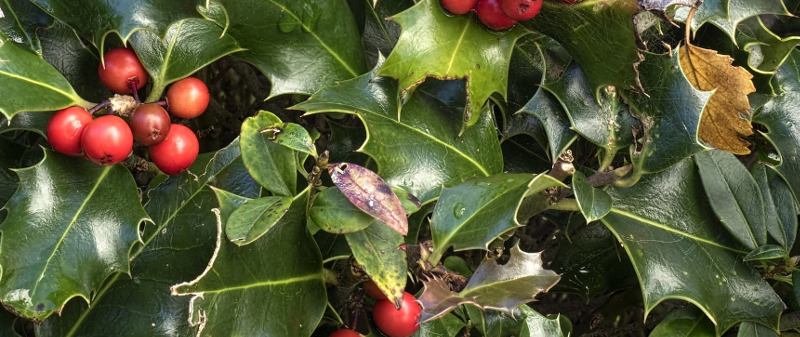Fortunately hollies have few problems in the landscape. They are very hardy plants and easy to care for. Most problems that occur are rare but can come from external environment issues. If not treated properly, you can risk the plants not looking their best, or eventually dying if the problem gets bad enough.

Holly Diseases
Most diseases for hollies are caused by the environment or location where the plant is. Too much moisture, not enough airflow, & poor soil are the most common issues that cause fungus and diseases for holly bushes.
Chlorosis - As far as diseases, you may see leaves becoming yellow. It more than likely is a sign that the pH is off in the soil and is referred to as chlorosis. You should check the pH of the soil. If it is 7.0 or more, you need to adjust the pH. The best way is to send a soil sample to your land grant university. They can supply you with the correct information on how to adjust the pH with the proper amount of acidifier.. You can always contact your county extension agent for more information.
Fungal diseases - If you see black or purple spots on your holly, that is usually a fungal disease starting. It could possibly be Tar Spot, sooty mold, or purple blotches. It is unsightly and will spread unless conditions change. It is best to remove the leaves and dispose of them in the garbage. Watering at the base of the plant and in the mornings will also help prevent the fungus from spreading even more. You can also apply a fungicide designed to kill fungus on hollies and other plants.
Cankers - Sometimes you may find sunken open wounds on the holly branches. Those are referred to as cankers. It is critical that you remove the branch as far back as possible into healthy wood. After each cut, you must disinfect your pruning tool with undiluted rubbing alcohol so as not to spread the disease. Be sure that you are watering your holly at the base of the plant and not overhead watering which can cause fungal diseases. It is also very important to have good air circulation around your holly which helps prevent disease.
Holly leaf blight - this is common in the Pacific northwest region up to Canada. It is caused by a fungus-like organism called Phytophthora ilicis. This can cause black root rot or trunk cankers. It spreads when there is free running water above the surface. So the best way to treat this is to prevent too much moisture in the soil. To treat holly leaf blight, improve the conditions of too much moisture around the plant. You can then apply a fungicide to kill the fungus. If you do not first improve the conditions, then there is no point in using the fungicide until that part is completed.
Spine spot - this is very similar to purple blotches and caused by drought, injuries to the plant or poor nutrients in the soil.
Scorch - this is caused by rapid changes in the weather, typically in late winter as the season starts to warm up dramatically, but still have extreme cold periods. Usually this is just browning of the leaves, and can be prevented by providing shade during very hot days in late winter.

Holly Pests
Hollies are bothered by very few insects. Here are the most common pests that can negatively impact holly shrubs.
Holly leaf miner - You may see leafminers which cause a haphazard trail through the leaves. The leafminer is inside the leaf so you won’t be able to physically see it. If there isn’t a lot of damage, you can simply remove the affected leaves and put them in the trash. If there is more damage, you can select an insecticide that is registered for use on hollies and targets leaf miners. You will find that on the label. Avoid home remedies. You can damage your holly and possibly kill it.
Spittlebug - You may also see a spittle bug which looks just like it sounds, a foamy white substance. There are usually only a few on a shrub so simply take a piece of paper towel and wipe it off. There is a tiny insect inside the foam that causes it.
Scale - On rare occasions you may find that you have scale (or sometimes called tea scale). Scale insects can vary in shape, size and color but you will find them as bumps on branches and twigs. They can be brown, beige, white as well as being soft or hard shelled. You can’t see legs unless you put them under a hand lens. Most people don’t realize they have them until they see a decline in plant health. As they feed they excrete a substance that causes sooty mold, a black fungal deposit which attracts ants and bees. Scale is extremely difficult to remove from hollies. It is best to take a piece of a branch to a local extension office for identification and for advice on treatment.
Spider mites - spider mites are tiny insects that you can barely see with the naked eye. The insects can cause damage to hollies, but more often it just causes a discoloration of the foliage. To treat spider mites, add ladybugs to your garden. Or you can use soapy water to clean off the leaves 1 by 1 as well.
Holly Pests Chart
|
Pest |
Identifying |
Treating |
|
Holly Leaf Miner |
Small fly with a shiny black body and yellow markings |
Remove the affected leaves and put them in the trash |
|
Spittlebug |
Small, sap-sucking insect that covers itself in frothy, white foam |
Take a piece of paper towel and wipe it off |
|
Scale |
Brown, beige, white as well as being soft or hard shelled |
Take a piece of a branch to a local extension office for identification and for advice on treatment |
|
Spider Mites |
Oval-shaped bodies, commonly being red, yellow, green, or brown |
Use soapy water to clean off the leaves one by one |
Sources:
"Holly Diseases." PennState Extension. extension.psu.edu
"Holly Diseases and Insect Pests." Clemson University Cooperative Extension Service. hgic.clemson.edu
 |
Author Denise Schreiber - Published 10-11-2021 |
